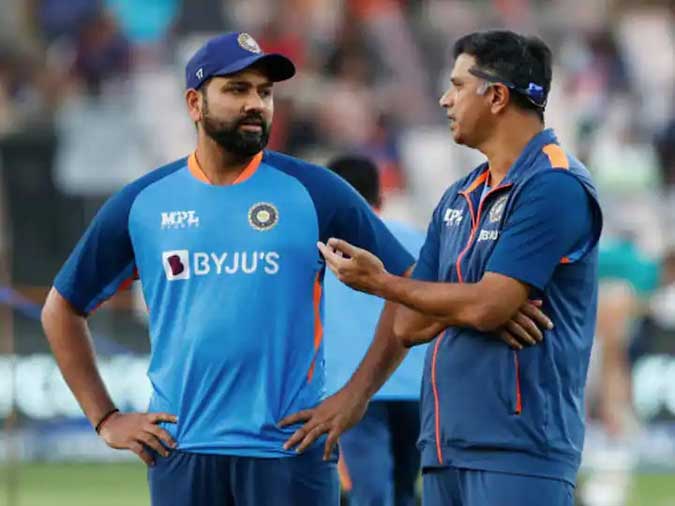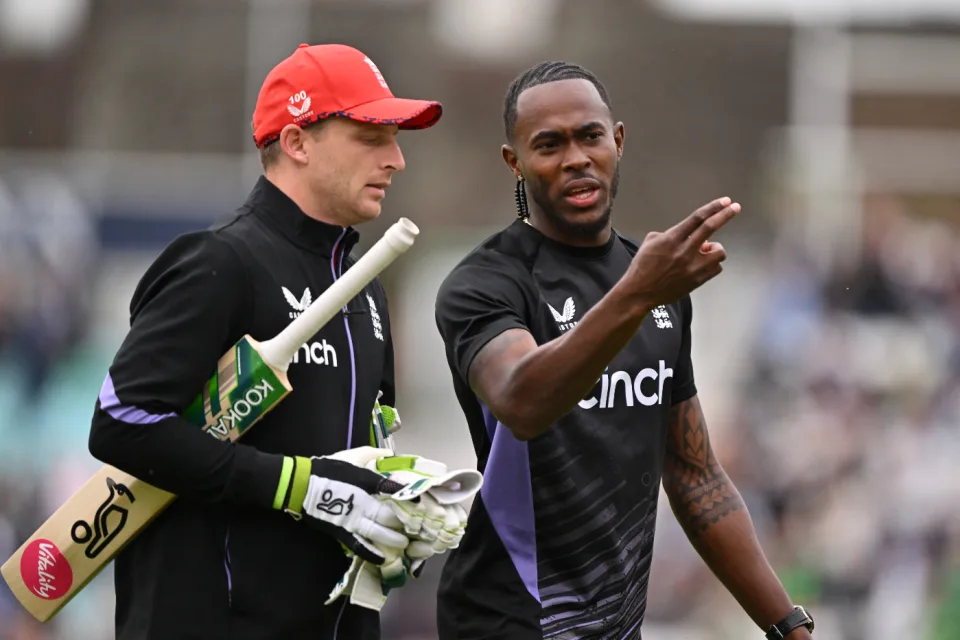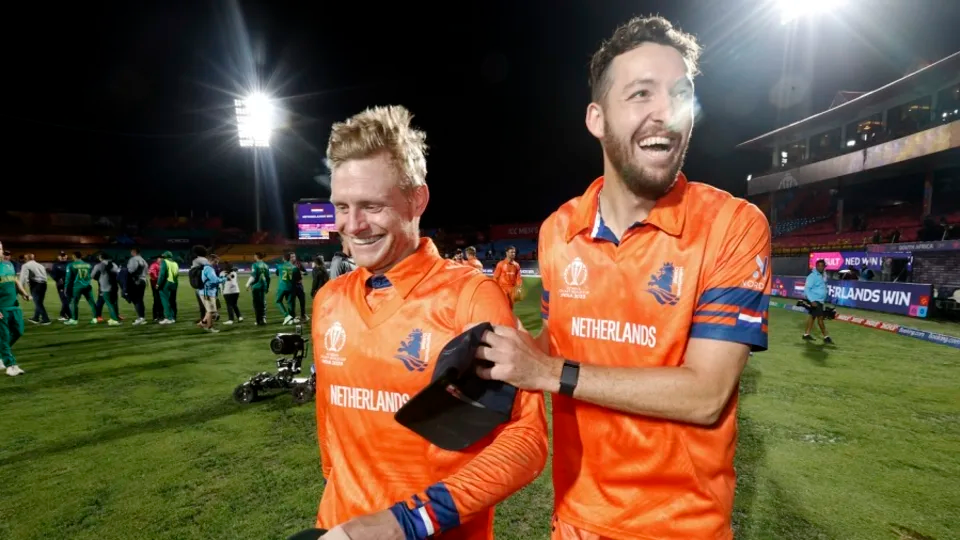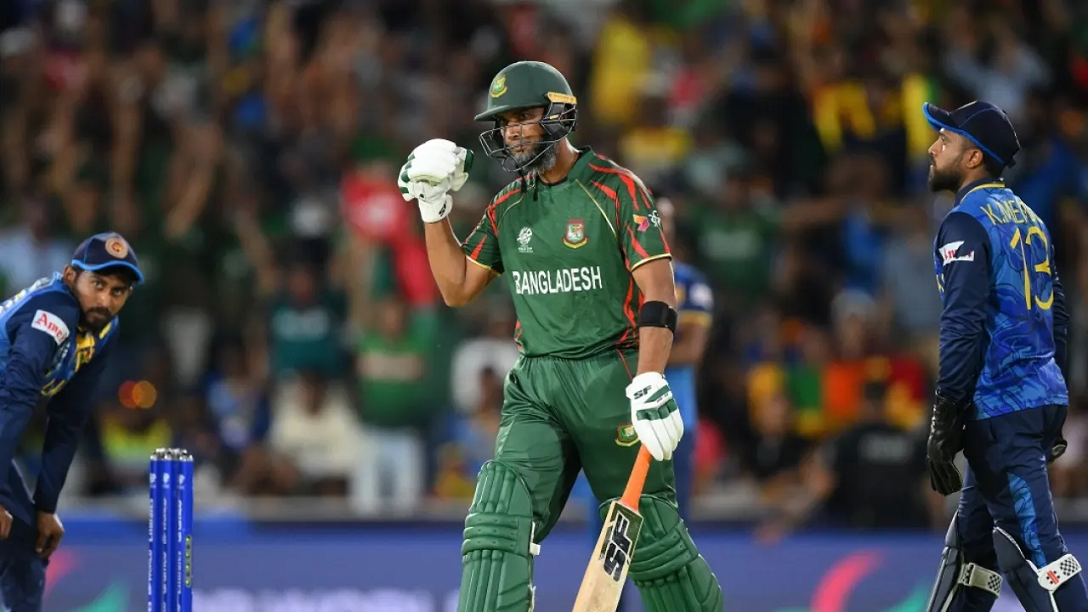Sports
Rohit Sharma’s Test captaincy faces its first huge test

It’s been a little over a year since it officially began, but has the Rohit Sharma era as India captain really begun at all?
It’s made a spluttering sort of start in Test cricket: Rohit missed three of India’s five Tests since he became their all-format captain. Injuries, in fact, have forced Rohit to miss eight of India’s last 10 Test matches. He was Player of the Match in India’s last Test before this stretch of games, a landmark victory that took them to a 2-1 series lead in England, months after they had beaten Australia 2-1 in Australia.
Since then, India’s world-beating aura has faded somewhat – they lost Tests they could have won in Johannesburg, Cape Town and Birmingham, and won one they could quite conceivably have lost in Dhaka – and Rohit has mostly been an absent figurehead.
He has had more of a chance to make an impact as a white-ball captain, and his overall results have been fantastic. Rohit has the best win-loss ratio of any India ODI captain who has led at least 10 times in that format, and only Hardik Pandya, who has only captained in 11 matches, sits above him on the corresponding T20I list.
Reaching the semi-finals of the 2022 T20 World Cup a year after exiting the same tournament at the group stage could be seen as a significant achievement for both Rohit and Rahul Dravid, who took over as head coach after the 2021 tournament. But it wouldn’t be lost on either of them that, for all the gains India made as a T20I side between the two tournaments, particularly in terms of batting approach, the same failings cost them in both 2021 and 2022.
Dravid knows from experience that tournament results end up defining captains, and that one bad tournament can cancel out the goodwill earned via bilateral results, especially in white-ball cricket. He could be remembered as the captain who turned India into a world-class chasing team in ODIs, but it’s likely that far more remember him for leading India to a group-stage exit at the 2007 World Cup.
Process dominates cricket discourse far more in Rohit’s era than it did in Dravid’s, but results – specifically results in “big” games and tournaments – eventually come to define the tenures of captains, coaches and selectors.
That Rohit succeeded Virat Kohli was itself, in part, down to a sense that he would be a big-tournament captain, and India had been starved of big-tournament titles since 2013. At the time he took over the white-ball teams, Rohit had just won his fifth IPL title as Mumbai Indians’ captain, and there were three ICC trophies up for grabs in the next two years.
Tournament results are, of course, heavily dependent on how good a team is relative to the competition, the format – one or two bad days are enough to send a strong contender out of the T20 World Cup at the group stage than they are to prevent one from reaching the IPL playoffs – and luck.
When teams win, though, the complicated story of their success is often simplified, and retold with the captain cast as some sort of all-knowing, benevolent mastermind. In the media, this premise is usually backed up with player testimonials – it’s a fresh surprise each time players in winning teams say good things about their captains, no doubt – rather than any analysis of how this superhero captain’s decision-making differed from that of other captains in similar situations, and no one ever asks whether the same team, filled with so many other winning ingredients, could have just as easily won with a different captain.
For whatever it was worth, then, Rohit came to the India captaincy with something of an aura. Now, just over a year since becoming all-format captain, there are threats to his leadership in every format.In T20Is, the threat has a name. Hardik has captained India in every T20I they’ve played since the World Cup semi-final against England in November. Rohit scored a scratchy 27 off 28 balls in that match, and he hasn’t played a T20I since. Now this is mostly because India are building up to an ODI World Cup and are looking to rest their senior players from T20Is, but it’s not inconceivable that one or more of the young top-order contenders who are now getting their chance could make themselves exceedingly difficult to leave out by the time T20Is become top priority again.
The future of Rohit’s ODI captaincy, meanwhile, could hinge on whether or not India translate their status as favourites for this year’s home World Cup into actually winning it. It’s an unfair amount of pressure, but it is what it is.
His Test captaincy, of course, has barely begun at all.
It’s against this backdrop that Rohit will lead India in one of Test cricket’s highest-profile contests. The 2016-17 Border-Gavaskar Trophy was perhaps the greatest Test series India has hosted this millennium – yes, arguably even greater than 2000-01 for the range of quality performances from both sets of players – a series where Australia made them reach into their deepest reserves of skill and stamina to complete a 2-1 comeback win.
The Australia of 2022-23 could be an even better collection of players than the one that toured in 2016-17, and could be an even better team if they address one key structural issue – the seeming lack of a quality second spinner.
India will, as ever, begin the series with a formidable spin attack and, despite the absence of Jasprit Bumrah, a group of quicks who are often deadly in home conditions. The batting will give them a few more headaches: India will be without Rishabh Pant’s genius and – for the first Test at least – Shreyas Iyer’s counterattacking flair against spin. This is a worry because they’ve been India’s best batters in subcontinental conditions since the start of 2021, a period in which Cheteshwar Pujara has averaged 34.61 in Asia and Virat Kohli 23.85. Rohit’s red-ball rhythm, meanwhile, is a bit of an unknown, since he hasn’t played a Test match since March 2022.
For all that, India should still be favourites, but if you’re an India fan and your normal pre-series anticipation is tinged with a sense of nameless dread, it could be because of this: R Ashwin is 36; Rohit, Pujara and Umesh Yadav are 35; Kohli and Ravindra Jadeja are 34; and Mohammed Shami is 32. Ishant Sharma and Ajinkya Rahane, both 34, may already have played their last Tests.
It’s fallen upon Rohit to captain India’s most successful generation of Test cricketers when they’re ageing at the same time. Managing this transition could be an exceedingly tricky task, and quite a lot of it – what can a mere captain do, for instance, to unearth successors to all-time greats? – is beyond his control, but it’s one other thing he’ll be judged on, for better or worse.
The Rohit Sharma era, then, could be a short one. And if this series against Australia – upon whose outcome hinges India’s qualification for the World Test Championship final – doesn’t go to plan, it could threaten to end before it’s even had a chance to properly begin.
(cricinfo)
Sports
England face Australia in the battle of champions

The first truly heavyweight clash of this expanded T20 World Cup format comes freighted with both history and subplots. A rematch of the 2010 World T20 final at Kensington Oval, the match pits Jos Buttler’s defending champions – who are aiming to become the first team to retain the trophy – against the Australian winning machine, victors at the 2021 edition and current world title-holders in Test and ODI cricket. And that’s before you throw in the Ashes for afters.
Already there is added pressure on England, after the rain in Bridgetown led to a share of the points in their opener against Scotland (and that having conceded 90 runs from 10 overs without taking a wicket in a tepid bowling display). Lose to their oldest rivals and it will leave their Super 8 prospects open to being waylaid by the perils of net run-rate calculations, or worse.
The Scotland match was the third abandonment in five suffered by England, after a rain-affected home series against Pakistan, which has clearly hampered their readiness for this campaign after almost six months without playing T20 together. It does not take much for a side to click in this format – and England looked in decent shape when they did get on the field against Pakistan – but Buttler will be anxious for things to go their way on Saturday, if only to avoid further questions referencing the team’s disastrous ODI World Cup defence last year.
Australia, under the laidback leadership of Mitchell Marsh would love nothing more than to add to the English sense of jeopardy – having helped bundle them out of the tournament in India on the way to taking the crown. Their head to head record is less impressive in T20 however, with England having won six of the last seven completed encounters, as well as that 2010 final.
Despite a wobble with the bat, Australia avoided mishap against Oman earlier in the week, the experience of David Warner and Marcus Stoinis shining through in difficult batting conditions. Surfaces in the Caribbean – not to mention those games staged in the USA – have already had teams scratching their heads; rather than the “slug-fest” England had prepared for, following a high-scoring tour of the Caribbean in December, it looks as if boxing smart may be the way to go.
Speaking of Warner, this could be the last time he faces up against England in national colours – and another match-winning contribution would likely reduce the chances of them meeting again in the knockouts. On the other side of the card is Jofra Archer, fresh from an emotional maiden outing at Kensington Oval and ready to take on Australia for the first time in any format since 2020. Can Mark Wood fire up England’s campaign, as he did during last summer’s Ashes? Will Pat Cummins be back to harass the old enemy once again? Seconds out, it’s almost time to rumble.
Cummins is set to return after being rested for the Oman game, which saw Mitchell Starc leave the field with cramp. Starc is understood to be fine and could keep his place – which would likely see Nathan Ellis miss out. Marsh is still not fit to bowl, with Australia likely to continue with the allrounder combination of Stoinis and Maxwell to give them cover.
Australia (probable XI): David Warner, Travis Head, Mitchell Marsh (capt), Glenn Maxwell, Marcus Stoinis, Josh Inglis (wk), Tim David, Pat Cummins, Nathan Ellis/Mitchell Starc, Adam Zampa, Josh Hazlewood
The one change England may consider is Reece Topley coming in for Wood, with the expectation that there will be some rotation among the seamers through the course of the tournament.
England (probable XI): Phil Salt, Jos Buttler (capt & wk), Will Jacks, Jonny Bairstow, Harry Brook, Liam Livingstone, Moeen Ali, Chris Jordan, Jofra Archer, Adil Rashid, Reece Topley/Mark Wood
[Cricinfo]
Sports
South Africa up against their bogey team in batter-unfriendly New York

Once is coincidence, twice is a clue, and three times is proof.
To paraphrase Agatha Christie, that is the narrative around South Africa’s meeting with Netherlands at this T20 World Cup.
The Dutch beat South Africa at the 2022 tournament and ended their semi-final hopes in a match where South Africa appeared to be sleep walking, and then beat them again at the 2023 ODI World Cup, where they exposed South Africa’s vulnerability in the chase. If they to do the treble, not only will Netherlands take the lead in Group D, but they will offer conclusive evidence of the threat they pose to Full Members, especially South Africa.
Of course, it will take some doing after South Africa’s opening performance against Sri Lanka, where they reduced their opposition to their lowest T20I total and chased it down in fairly straightforward fashion thanks to the most stable middle-order of their white-ball era. In Aiden Markram, Tristan Stubbs, Heinrich Klaasen and David Miller, South Africa have bankers and big-hitters and, for this match, they also have the advantage of experience. They’ve already played at Eisenhower Park, and have first-hand knowledge that run-scoring doesn’t come easily;Klassen said they are prepared to use their “cricket brains” and play “smarter cricket”.
But the conditions could be good news for Netherlands, who are not naturally a line-up of big hitters and build their innings on a foundation of turning ones into twos. In other words, they tend to take a slightly more conservative approach to batting, which may work well here, but they’ll be wary of the uneven bounce of the surface and will have to come up with plans to counterattack especially against South Africa’s seamers. Their own bowlers were exemplary in Dallas and will look to build on that performance against a line-up that will likely be more proactive than Nepal’s, but who they have managed to keep quiet not once, but twice in the past. Third time’s the charm, they say.
Anrich Nortje’s stunning return to form against Sri Lanka means South Africa may not have to tinker with the bowling combination, and Gerald Coetzee and Tabraiz Shamsi may have to wait their turns to get a game. The batting line-up should be unchanged, with no space for Ryan Rickelton yet.
South Africa: Quinton de Kock (wk), Reeza Hendricks, Aiden Markam, Tristan Stubbs, Heinrich Klaasen (wk), David Miller, Marco Jansen, Keshav Maharaj, Kagiso Rabada, Ottneil Baartman, Anrich Nortje
Conditions in New York may tempt Netherlands to include an extra seamer and they have Kyle Klein in their squad. But it could come at the expense of a shortened batting line-up and they may not want to risk that.
Netherlands: Michael Levitt, Max O’Dowd, Vikramjit Singh, Sybrand Engelbrecht, Scott Edwards (capt, wk), Bas de Leede, Teja Nidamanuru, Logan van Beek, Tim Pringle, Paul van Meekeren, Vivian Kingma
[Cricinfo]
Latest News
Mustafizur, Rishad, Hridoy dazzle in Bangladesh’s tight two-wicket win over Sri Lanka

Nuwan Thushara’s last over brought Sri Lanka screaming back into the match,as he first bowled Rishad Hossain, and then nailed Taskin Ahmed in front of the stumps with a pinpoint swinging yorker. This left Bangladesh eight wickets down, with 12 runs still to get.
However, the experienced Mahmudullah was at the crease for Bangladesh, and despite some further nervy moments, pushed Bangladesh across the line off the last ball of the 19th over.
But this was a match chiefly decided by Bangladesh’s own outstanding bowling. Mustafizur Rahman was the best among them, using shorter lengths and his cutters efficiently, to claim figures of 3 for 17. Rishad Hossain’s three-for through the middle overs also kept Sri Lanka quiet.
Mustafizur was instrumental in Sri Lanka’s downward spiral through the middle overs, which culminated in a crash-and-burn end. Ultimately, their inability to find boundaries, or even rotate strike against good Bangladesh bowling resulted in their downfall. A score of 125 for 9 always seemed poor on a decent pitch, even if their bowlers made a match of it in the end.
Brief scores:
Bangladesh 125 for 8 in 19 overs (Towhid Hridoy 40, Litton Das 36; Dhanajaya de Silva 1-11, Nuwan Thushara 4-18, Wanidu Hasaranga 2-32, Matheesha Pathirana 1-27) beat Sri Lanka124 for 9 in 20 overs (Pathum Nissanka 47, Dhananjaya de Silva 21; Tanzim Hasan Sakib 1-24, Taskin Ahmed 2-25, Mustafizur Rahman 3-17, Rishad Hossain 3-22) by two wickets
[Cricinfo]












